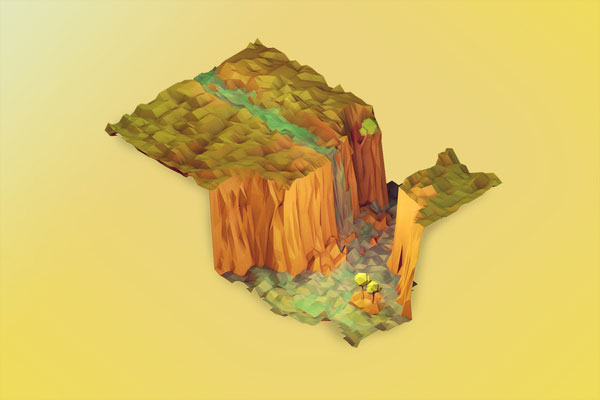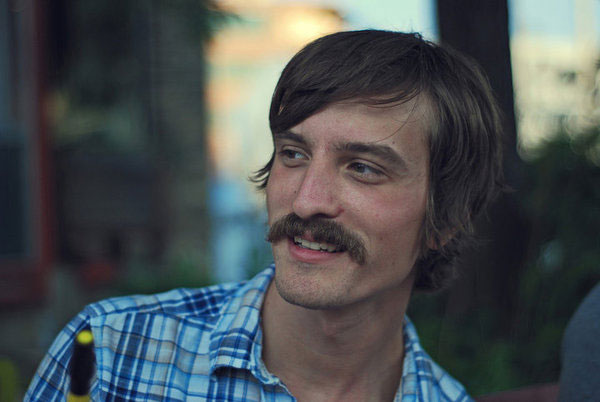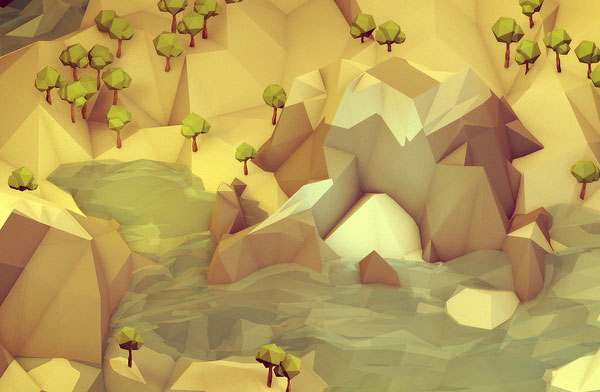One Minute With…
Timothy J. Reynolds

Hi Timothy, thanks for taking the time to chat with One Minute With. Tell us a little bit about yourself and your work.
Hi, thanks for the interview! I’m a 3D illustrator currently living in Milwaukee, WI but was born and raised in Winston-Salem, NC. I moved here for a job about three years ago. Just before that, I had sold everything I owned back in early 2009 and left my hometown to look for something more. I lived in Denver for a few months, drove around the country for a bit freelancing out of hotel rooms and then spent the better part of a year in Atlanta.
How did you get into design? Was there a defining point in your career, and if so, how did it shape you as a designer?
Pretty typical story there in that I’ve always drawn since I was old enough to hold a crayon. Rainy days after school just meant stay inside and draw. I really enjoyed all of my art classes more than any others throughout school. But it was probably during the first year of college that I realized I wanted to do something design-related. I can still remember the first time being introduced to Photoshop [version 6, I think] as a freshman in college and just staring at all of those confusing buttons. I knew then that I had to figure how to use it. Then a few years later, I went back to school for architecture where I stumbled into 3D software [SketchUp] and I fell in love with it. Building and moving stuff around in 3D space was like a dream come true. 2006-ish. That’s when I knew [loosely] what I wanted to do.

If you could change one thing about your career to date, what would it be?
I don’t think I would change anything about my career so far. I’ve been lucky enough to work in a few different industries that have really helped me progress as a designer. I’ve worked for architecture firms, trade show companies, and marketing agencies.
You’ve got a pretty unique style, full of low poly 3D renders. Do you think it’s important to have a style in an industry as diverse as ours? Did you set out to develop this style, or did it just evolve naturally?
Sure, I’d definitely say style is important. But I also think being able to offer a variety of styles, or even having a few different skill-sets, is important. If the whole low-poly bubble bursts tomorrow, and it might, I’m really fortunate to also have a grasp in exhibit design and architecture, too. I spent years trying to figure out a style that I was not only happy with how it looked, but happy to make. The process is a wonderful thing. From sketch to modeling to lighting to rendering to post, it’s all so much fun. Every time I open Cinema 4D and see that blank screen with all of those buttons, I get excited. I’m sure other illustrators feel the same way about Photoshop/Illustrator/etc.
So you studied architecture in college – How does that translate into the work you’re doing now? Do you think it proved to be worth the investment, both in time and money?
It’s funny, I initially went to a university for a few years but ending up just taking art classes and ignoring all of my “required” classes. Apparently, they don’t care for that. I got away with it for a good two and half years, though. It was a fun “party” school in the Appalachian Mountains of NC [ASU]. After I came home and tried to figure out what was next, I enrolled in a 2-year Associate’s degree in Architecture. That’s where I was introduced to 3D software. I quickly fell in love with the possibilities. Finished that up in 2006 and started working in the industry the same week I graduated with a firm my Professor hooked me up with. I quickly figured out that architecture might not be a perfect fit for me. It was a bit too technical and I knew from school that I was in for [at least] 5+ years of grunt work just to possibly get anywhere with it and/or to be able to do anything creative in the field. I was in for years of being a “CAD monkey.” And I definitely did not enjoy AutoCAD and that was essentially what my degree bought me a job in. Long story short, that quick, affordable degree was a stroke of luck that set me on the right path.

A few years back, you essentially started a whole new life for yourself, selling all of your possessions and moving state. Can you tell us that story? Has it had a positive impact on your life, do you feel?
Oops, I hit on that a bit in the first question. Sorry! But sure, I can talk more about it. I think it had just become more and more evident to me that I needed to leave my hometown. I had recently turned 26 and felt an internal panic that I was going to die there, that I wasn’t going to ever find what[ever] I was looking for there. That might sound dramatic, but I really felt that way and I knew I had to take off. Obviously, leaving family and friends and everything I’d ever known was tough but it was necessary. I feel like I’ve grown so much in the last few years in ways that would have been impossible had I stayed in North Carolina. I had a great job as an exhibit designer that I had been at for a little over a year and had worked in an architecture firm for about a year prior to that. With that, I kinda just crossed my fingers that it would be enough experience to get work wherever I ended up. Selling everything I owned was truly amazing, though. Really liberating to get rid of everything I had previously found “value” in. Mostly eBayed everything I had that was worth anything and somehow talked a buddy into buying ALL of my furniture/TV/desk/etc in one fell swoop. With all of that done, I put in my two-weeks notice and tied up all loose ends. Hopped in my car in February of 2009 with an iMac and a box of clothes. Oh yeah, and my snowboard. [Denver-bound, initially] There’s lots more to the story from between then and now, but I’ve rambled enough already.

If, in some Freaky Friday-like situation, you could live the life of another designer, illustrator or creative, for a day, who would it be, and why?
Hmm, tough question. I’m going to have to go with J.G. Quintel. For anyone who doesn’t know who that is, he’s the creator of Regular Show. It’s a hilarious cartoon on Cartoon Network. I think I would just love to have seen an idea that far through. They just hit their 100th episode and I can only imagine the amount of work that goes into something like that. Especially a hand-drawn animated show. I’d also love to be surrounded by a team of people that I can trust like that and have fun with on a daily basis. That show’s got something pretty special, in my opinion. I hope it goes on for another 100 episodes.
How would you define success? Do you think you’ve found it yet?
I’m definitely still trying to figure out what I’m really doing. I still work full-time for a marketing firm as a Sr. 3D Designer and moonlight as a 3D Illustrator for lots of different clients. I’ve been really fortunate in the last 18 months or so, picking up solid, consistent work from tons of different startups, agencies and magazines. What started out as just experiments doing tons of personal work has now turned into paid work. I couldn’t be more grateful. I’ve always shared my work on Flickr for years but it always felt very much like a black hole that no one really ever saw or responded to. But once I started making so many of these little worlds and just kept posting them, I started to pick up a little steam. So, to answer your question, I’m still looking for “success” but I definitely feel better/closer than I was yesterday. The future is exciting.

And finally, what tips would you give to anybody who is looking to get started in design?
I think the best advice to anyone starting out is what they’ve already heard before; make work. Make lots of work. Make the kind of work you want to get paid to make. Make work that you love doing. Make work that challenges you, that you care about, that you’re proud to show. And then do just that; show it. Make, show, repeat. There’s that great Ira Glass quote about this exact thing, and I definitely think he hit the nail on the head.
Thanks so much for the interview, Conor. I’m honored to be among all the great designers you’ve talked to so far.
Thanks Tim!
Many thanks to Tim for sharing his thoughts with One Minute With. I really enjoyed his answers, and I hope you love the interview as much I do!
Check out Tim’s site, and follow him on Dribbble and Twitter?